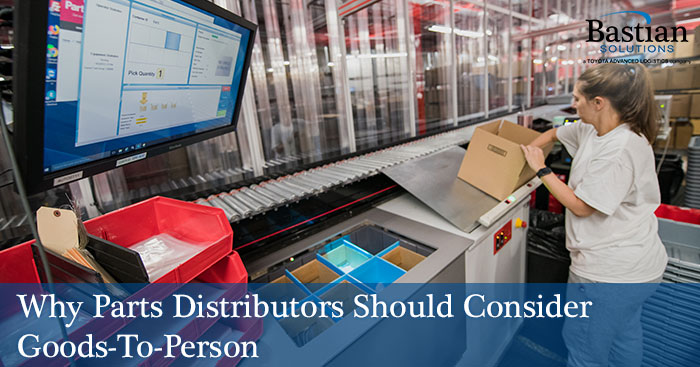
Why Spare Parts Distributors Should Consider Goods-To-Person
Kyle Dorge | 18 December 2019
For leading original equipment manufacturers (OEM), aftermarket business is anything but an afterthought. According to Industry Week, aftermarket business represents 8% of total US GDP and can make up 40-60% of a company’s total revenue [1].
Over the years, Bastian Solutions has partnered with OEMs & spare parts distributors, like Parts Town, to enhance their aftermarket business through improvements to their order fulfillment systems and processes. What we’ve found is that goods-to-person systems are often a great fit for spare parts warehousing. Here’s why.
High # of SKUs stocked
The number of SKUs on-hand in spare parts warehouses is often upwards of six figures. Giving each SKU its own forward location on the floor requires a large footprint and forces pickers to travel long distances. Goods-to-person systems utilize the vertical space of your building to minimize your forward picking footprint & provide quick access to all SKUs inside the system.
Hard-to-predict SKU demand
It’s difficult to forecast what parts will fail & when they will fail for end users, which creates major challenges when trying to slot SKUs into an appropriate forward pick medium (pallet flow vs. carton flow vs. shelving vs. high-bay rack). The need to slot essentially goes away with goods-to-person systems.
Lean stocking strategy
For most parts, a small number of units can represent several months, or even years, worth of demand. Therefore, clients typically keep small quantities of an item in stock. These SKUs’ whole inventory can be densely stored inside a goods-to-person system – avoiding the need for reserve storage and replenishment activity.
Modest fluctuations in demand across the year
Aftermarket sales typically don’t experience peaks and valleys in demand across a year like consumer goods sales experience. Having relatively steady demand prevents the need to “oversize” the system’s capacity and allows the client to maintain a high system utilization across the entire year.
Quick order turnaround
Typical equipment end users wait to purchase spare parts until their part(s) break and the equipment is no longer usable. So, oftentimes there is a high urgency associated with fulfilling spare parts orders. Goods-to-person systems provide quick responsiveness and high throughput rates to ensure late orders still make it on the truck.
Variety in order sizes/types
Aftermarket support is typically made up of several customer types, such as other distributors, partner dealers, and direct end users. The order sizes & service level agreements can differ significantly among customer types. Goods-to-person systems give clients the flexibility to work on multiple order types, either simultaneously or independently. Bastian Solutions’ Warehouse Execution System, Exacta, orchestrates the flow of work through goods-to-person systems to maximize throughput while still honoring your business’ rules.
Source:
[1] https://www.industryweek.com/companies-amp-executives/avoid-turning-your-aftermarket-afterthought
Kyle is an Associate Consulting Engineer with Bastian Solutions out of Indianapolis, IN. In this role, he works with Bastian clients to develop and validate material handling system designs through extensive data analysis and computer simulation. Kyle received his B.S. degree in Industrial Engineering from the University of Missouri and is currently pursuing his M.E. degree in Sustainable Engineering from Rochester Institute of Technology.
Comments
No comments have been posted to this Blog Post
Leave a Reply
Your email address will not be published.
Comment
Thank you for your comment.